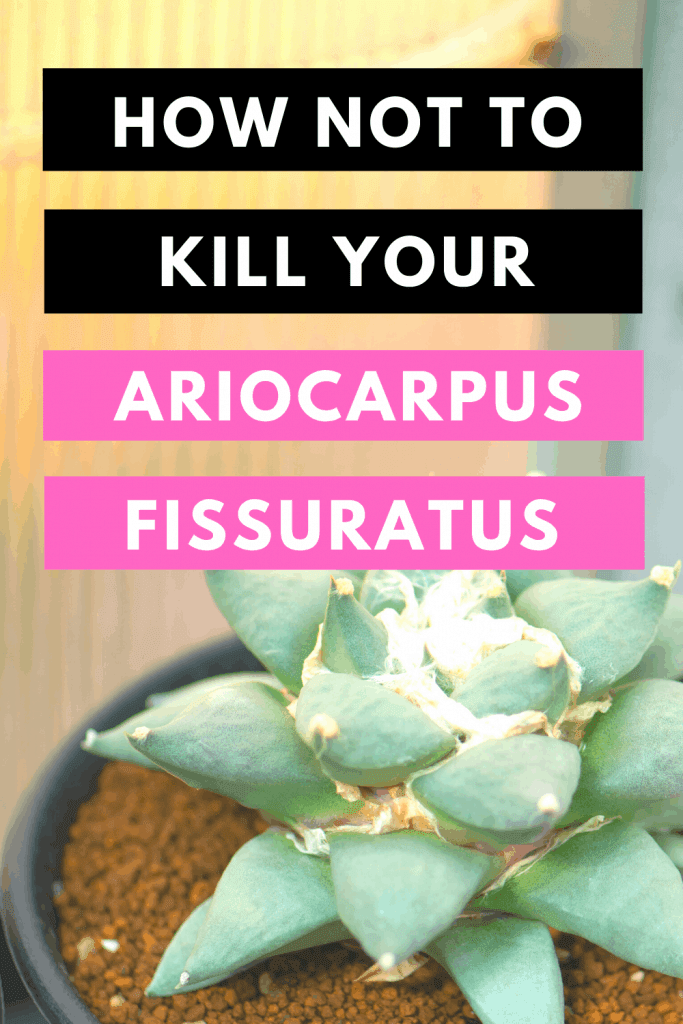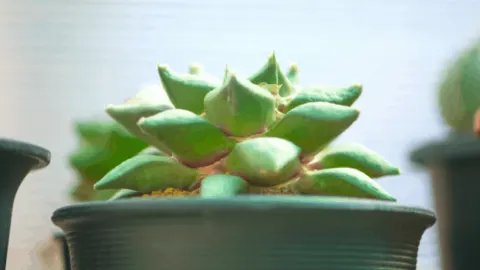A thick-skinned plant that is fleshy in nature, ariocarpus fissuratus hails from the cactus family that originates from parts of Texas and northern Mexico.
At first glance, they seem to be on the flatter end of the spectrum among other cacti species. Although closer look and you will see how unique ariocarpus fissuratus is.
They look like stars when viewed aerially and they go on as layers like that, which is called a rosette – a spiral arrangement of overlapping leaves growing on a shortened stem that is close to ground level.
Ariocarpus fissuratus is a genuinely unique, but rare species. They are grown in small clusters when in nature. However, this cacti species is on the brink of extinction thus, many people are on the market for them.
These gems are hard to spot in nature and such a rarity that people should conserve them as much as possible when they encounter them.
This gem of a cactus makes a wonderful, cute houseplant.
They are spineless and quite friendly. Ariocarpus fissuratus are greyish-green in color and sprout these beautiful pink flowers on top of them that give them a blast of color from their rusted green hues.
If you have the honor to host such a plant at home, read through to see how you can care for them and let them prosper.
Table of Contents

Ariocarpus fissuratus Plant Care Guide
SOIL
In its natural habitat, whether it is in Texas or Mexico, ariocarpus fissuratus lives on limestone-rich soil.
At home, the soil mixture ideally should be something of a loose mineral cactus mix that can be well drained as this cactus plant doesn’t do well sitting in moist to wet soil for a while.
When building your own soil mixture for ariocarpus fissuratus, you can use a store bought cactus mix, but ensure that the minerals are loosely mixed and use extra perlite or pumice to achieve the optimal drainage and proper aeration requirements.
Refrain from using regular plant soil mix, as they may not be able to provide enough air for the plant to breathe in.
LIGHT
An ariocarpus fissuratus enjoys proper sunlight that can be directly facilitated. Although, do keep in mind that the amount of sunlight it gets does depend on the climate of where you live.
In more temperate climates, you can place your ariocarpus fissuratus directly under the sun. If you live in a more hot and arid region, placing the plant in direct sunlight is okay, but only for a few hours at a time.
It would be best to avoid the peak hours of sunshine and if you cannot move your cactus somewhere shaded, at least have a cloth on hand to give it some shade.
WATERING
Like most cacti species, ariocarpus fissuratus can withstand long periods without being watered. Minimal watering is just perfect for these plant species.
The amount of watering depends on your living conditions just like its lighting needs. Living in parched areas would need more watering, like on a weekly basis, compared to living in tropical areas.
In terms of when to water this cactus, only water ariocarpus fissuratus after the soil has completely dried since its last watering. As a cacti plant that can survive without much watering, keep in mind that less watering tends to be better than over watering.
During growing season, a slight increase to moderate watering may be necessary. This can be done on a weekly basis during the summer months. Once the temperature starts to drop, gradually keep the cactus dry. In the winter, no watering is okay.
TEMPERATURE
When having an ariocarpus fissuratus at home, you don’t need to dramatically change your own living conditions for the sake of this plant. This cactus can survive in room temperature, perhaps even lower would be okay, too.
When going for temperature levels, try to keep ariocarpus fissuratus within the range of 20 degrees Fahrenheit (-6.7 degrees Celsius) to 50 degrees Fahrenheit (10 degrees Celsius).
Overall, they make easygoing plants to upkeep hence, nothing considerable is needed from your side.
HUMIDITY
For a cactus plant, ariocarpus fissuratus is no exception to being quite drought resistant. In other words, they have a high drought tolerance.
This plant species thrives better in low humidity levels as any moisture retained or too much water level will be damaging. As a result, that is why a well-draining pot is needed for such plants.
Most of the water that goes into watering these plants get retained in the bulky tubercles that allow them to sustain in dry and wintery times.
If you want a quantifiable reference point in terms of humidity, try to stick to moisture levels of about 30%. This would be the safest choice. These plants are tough to endure periods of parched conditions.
FERTILIZER
During the growing spring and summer months, you can fertilize your ariocarpus fissuratus once every four to six weeks. When you do fertilize, you can do so at the time you are watering them.
During the cold months, you can refrain from fertilizing your plant and just let them be.
In terms of fertilizer, you can dilute them at one-quarter strength of each nutrient – nitrogen, phosphorus and potassium. As with watering these cacti species, under feeding them with fertilizer is better than over feeding them.
For your general knowledge, fertilizers contain nutrients like nitrogen, phosphorus and potassium.
When purchasing fertilizers, you may notice a three digit number ‘#-#-#.’ This shows how many pounds of nitrogen, phosphorus and potassium there are in the mix, respectively.
PROPAGATION
To propagate ariocarpus fissuratus, you can do so using two methods. One method is to use seeds to initiate new growth. Another method is to use stem cuttings to carry out the growth of a new cactus.
Both methods will be discussed further in detail in the propagation section below.
GROWTH
When having an ariocarpus fissuratus as a member of your family, you are probably a highly patient person. These cacti are known to be extremely slow growers.
Sometimes, it can take up to 50 years to reach full-growth, which is about 20cm in diameter. The centered, star-shaped rosette grows to be about 8 inches in diameter.
The cactus grows close to the ground with the majority of the bottom part of the plant obscured in the soil. They are normally solitary; therefore, no branches grow out of the main root.
The bright, wool-felt pink flowers that are atop ariocarpus fissuratus can grow to be 2.5 to 5 cm tall, with width longer than its height when fully bloomed.
Their flowers typically last for three to four days. October and November are the blooming months for these flowers.
POTTING
For a plant that grows deep under the surface and wide horizontally, you would want to find a deep and wide pot.
After a year or two, expect a high chance of repotting your plant into a bigger pot.
Another characteristic of a pot to factor in is the material it is made out of. An ideal pot to use for ariocarpus fissuratus is a clay pot as they can help in draining the soil smoothly, especially one that has holes at the bottom.
Propagation in-depth/different methods and step-by step
To go into further detail as to how to propagate ariocarpus fissuratus, there are two ways as aforementioned above. Both ways are best done during the growing seasons of spring and summer:
One method to propagate ariocarpus fissuratus is by using seeds. If you use this process, keep in mind that it is a bit of a slow burn to see any growth. The seeds don’t like strong light and dry conditions.
You would need to monitor the conditions at home routinely. Using this method, all you need to do is add fresh soil into the pot and a bit of fertilizer before spreading the seeds around the surface.
Give it some water and place it in a lighted area that also gets shade.
The second method is to use stem cuttings, which may be faster. All you need to do is cut a part of the matured stem and let it dry completely before placing it into a pot of fresh soil.
Add a bit of fertilizer to help stimulate its growth and place it under the right conditions. This cactus starts fully blooming in 8 to twelve years, testing your patience levels!
Common Problems with Ariocarpus Fissuratus
A common problem with ariocarpus fissuratus is trying to find the right pot that will fit its deep-rooted, below-the-surface character.
As it grows, much of the plant is obscured from the surface. You may want to consult a plant expert to find the right pot for this gem.
Another problem is maintaining the right water levels and keeping check that the water can drain out of the potted mix properly.
Under-watering is always better than over-watering.
Tips to Keep Ariocarpus Fissuratus Problem-free
To address the common problems faced by ariocarpus fissuratus, constantly monitor the soil texture to assess that the soil can dry completely after each watering.
If not, you may need to repot. For a plant that has deep-rooted growth, it is recommended to check with an expert of this plant as to which pot is best and how to add in the soil to allow roomy growth.
Frequently Asked Questions About Ariocarpus Fissuratus
What do I do if I over-watered my ariocarpus fissuratus?
If you have over-watered your ariocarpus fissuratus, then leave it be until it can completely dry on its own. If it has been over a few days to a week and no positive progress is made, then consider repotting this plant.
Do I need to prune ariocarpus fissuratus?
No, ariocarpus fissuratus barely needs any pruning, if at all. They are a thick-skinned plant that has a thick-skinned personality that can survive even the roughest of conditions. The pink flowers that grow on top of the cactus only bloom for a few days, thus, you also don’t need to consider pruning the flowers.
How do you repot ariocarpus fissuratus?
Repotting ariocarpus fissuratus would follow the same steps and measures as potting the plant for the first time. If you find that over time, this plant species is starting to outgrow its pot, wait for the soil to completely dry up before disassembling. Normally, you would repot once every other year.
Remember that much of the base of the plant is tucked in soil. Once you displace it out of the soil, clean off any old soil stuck to it. Then, cut off the tip of the main root in order to encourage growth and a better intake of nutrients. Wait for this cut root to dry before planting it into new soil. Once this entire process is done, then you can happily place your ariocarpus fissuratus into its new and bigger pot.
Why are ariocarpus fissuratus called ‘living rock cactus?’
Ariocarpus fissuratus are called ‘living rock cactus’ because they grow so close to the ground that the majority of the lower surface of the plant are rooted into the ground. Hence, you can hardly see them as they conform to the ground, especially during dry periods where their stems shrink making them less visible as a plant and more as a rock.
CONCLUSION
Ariocarpus fissuratus is one of the more unique gems in the cacti family, quite unique that it is most sought after. They grow to have beautiful rosettes you can see from an aerial view, but they also can camouflage into Mother Nature as grounded plants.
They make the best “rock!” After several decades of watching this cactus take to its mature form, you will soon realize it was all worth the wait.
As always, living conditions must be factored into the care of your plants. This applies not only for ariocarpus fissuratus, but also for all plants outside this species.


